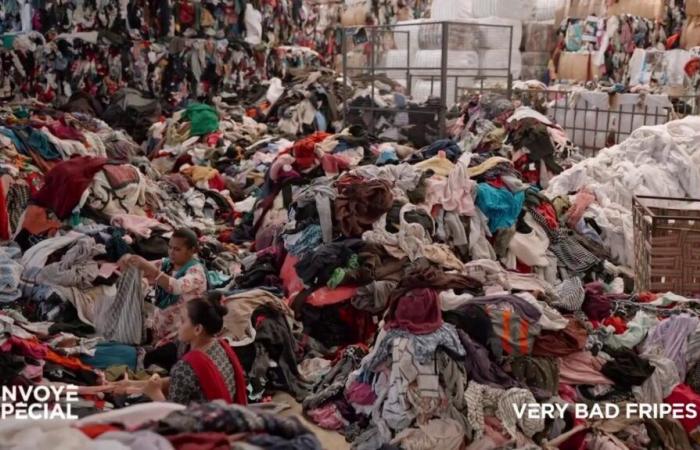Published on 21/11/2024 17:55
Updated on 21/11/2024 18:44
Reading time: 3min – video: 4min
How our used clothes end up in our thrift stores after being sorted… in India
How our used clothes end up in our thrift stores after being sorted… in India
(SPECIAL SUBJECT / France 2)
Where do these designer jeans found in a Parisian thrift store come from? To find out, “Special Envoy” crossed the borders to India. In the west of the country, visit a huge sorting center which receives tens of tons of used clothing every day from all over the world, including France.
Where do these designer jeans come from, bought for a few euros in a thrift store? What journey did he make before arriving in Paris? To find out, a journalist from “Envoyé Spécial” equipped him with a GPS tracker before placing him in a collection container. She was able to follow him to Europe's largest port, Rotterdam in the Netherlands, then lost track of him. No doubt it was at the bottom of a boat, on its way to the end of the world… Because just like new things, second-hand clothes travel around the planet before reaching our cupboards.
In 2023, 180,000 tonnes of second-hand clothing were exported. Most to Africa, which receives 37% of our old clothes, followed by Europe, 33%. Seventeen percent of our exports go to Asia, particularly India. But most often, it's not to stay there. Because India has become one of the hubs of the global second-hand clothing trade.
Exceptionally, “Special Envoy” was able to film in the economic zone of the port of Kandla, in the west of the country. It has around fifteen sorting centers for second-hand clothes that arrive from all over the world, including France. There is an incredible quantity of clothes. Everywhere, in an uninterrupted flow, mountains of fabric accumulate. Our jeans placed in the collection container have a good chance of passing through here.
In one of the largest second-hand clothes factories in the country, the “Special Envoy” team met the owner: Saddam Talu, sort emperor of second-hand clothes at the head of two immense sorting areas… which he plans to expand, “because the demand from European countries and Japan is really very strong.”
The 40 tons of clothing arriving here daily are sorted on the line, at a sustained rate, by the 450 employees of the US Clothing company. But why do this sorting thousands of kilometers away? ? If it were carried out in Europe, the operation would not be profitable, explains Saddam Talu. “This is not possible with machines, it is a long-term job. If the Europeans did it themselves, it would cost too much.” Without all these little hands paid between 80 and 150 euros per month to sort the clothes thrown away by Westerners, second-hand clothes would be overpriced.
Excerpt from “Very bad fripes?” a report to be seen in “Special Envoy” on November 21, 2024.
> Replays of France Télévisions news magazines are available on the Franceinfo website and its mobile application (iOS(New window) & Android(New window)), section “Magazines
France






